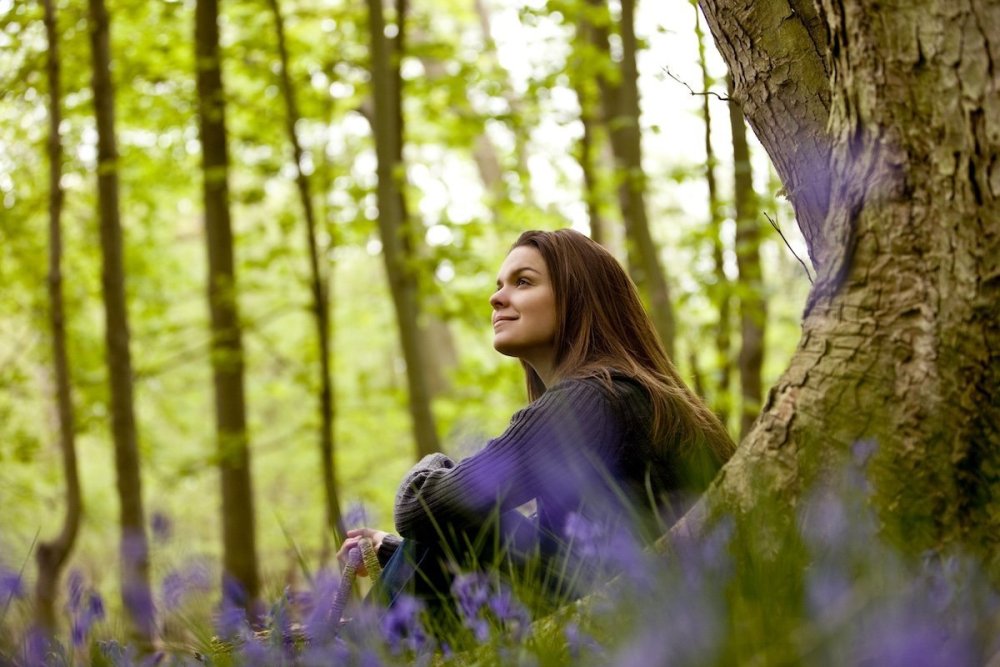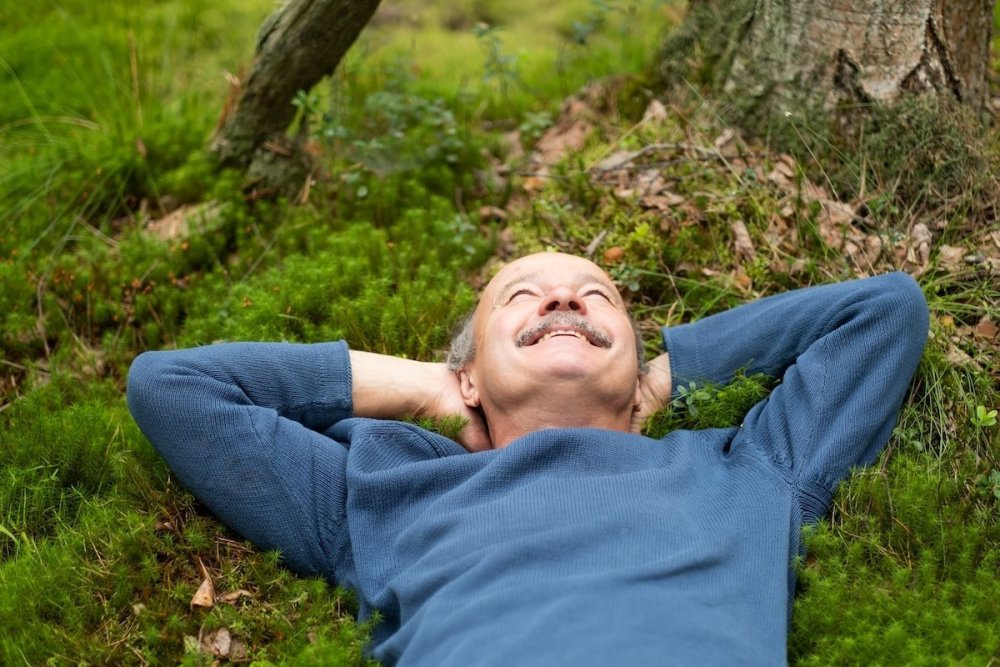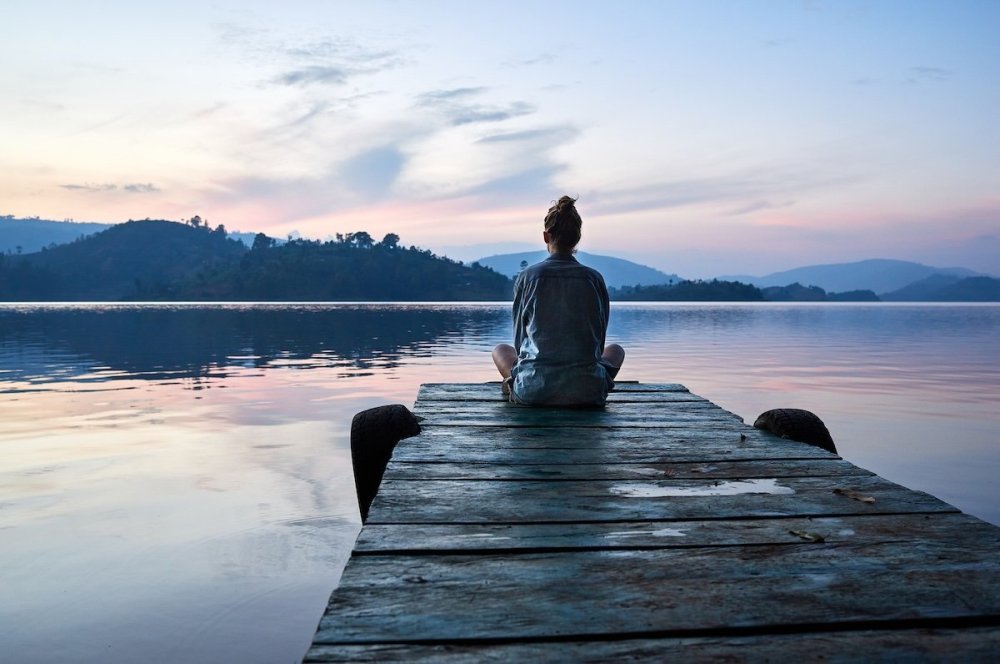Meditation doesn't have to be done sat inside on a mat. Ann Vrlak explores the science-backed benefits of meditating in nature and suggests 5 ways of practising it outdoors.
Among the many myths about meditation that exist is that it has to happen in a quiet room with your eyes shut. However, taking your practice outside can actually deepen your connection with nature, engage your senses, and bring a fresh perspective to what meditation is all about.
In some places around the world, doctors now actually prescribe time in nature as a tool for health and well-being. Nature meditation goes one step further, building on the instinctual connection humans have with the natural environment.

Meditating in nature is a sensory, calming experience
The benefits of meditation in nature
The value of spending time in nature is woven into many cultures. indeed, it's now generally accepted that it's one of the healthiest things we can do for our body, mind and spirit. Here are just a few of the further benefits you enjoy when you do simple meditation practices outdoors:
-
Being in a forest or park, or by the ocean, all have a soothing effect on your nervous system. Add in the benefits of meditation practice on stress relief, and outdoor meditation becomes an enjoyable, powerful tool to bust stress.
-
Nature meditation is a rich, sensory experience. Being outdoors is an ever-changing experience of sights, sounds, smells and sensations that you can immerse yourself in to ground yourself in the present moment.
-
Most of us live in a fast-paced world of electronic devices and multitasking. Meditation in nature supports you in settling into a quieter, simpler space where you can turn your attention inward.
- Finally, time in nature has been shown to be profoundly helpful for our mental health and mental clarity. Nature meditation multiplies these many healthy effects that help us to give our minds much-needed rest and rejuvenation.
5 ways to practise meditation in nature
Here are five nature meditation practices. For each one, whenever you notice that you're lost in a train of thought, that is part of the exercise. It is totally natural. Just gently return your attention to the focus of the practice.
1. Sound meditation
One main meditation myth is that the practice requires silence, but it doesn’t. In fact, paying attention to sensory information, especially sound, is one of the oldest forms of meditation.
“In some places around the world, doctors now actually prescribe time in nature as a tool for health and well-being. Nature meditation goes one step further.”
Meditation in nature, focusing on as many sounds around you as you can, is a wonderful, relaxing practice you can do while walking or sitting. But don’t go looking for sounds; let them come to you. Notice the different kind of sounds you can hear when you're outside – birds, other animals, wind in the trees, running water or rain –whatever you notice.

Listen to the birds through sound meditation
Benefits This meditation trains you to focus your attention in the moment, on your direct sensory experience. And, this focus on your senses, helps to calm your mind and nervous system.
2. Observing nature
Choose an object — a tree, a flower, a rock, a bird, a cloud — and observe it. Look at it as if you have never seen this thing before. Notice as many things about it as you can – its texture, colour, movement and shape. You will probably want to name it or remember information about it. “Oh, that’s a woodpecker. They are common…” That’s OK, but do your best to let go of what you know about it and just observe it as it is, and, if you can, connect with it.
MORE LIKE THIS:
- 4 Ways Nature Can Protect Your Well-Being
- Gazing At The Stars: Replace Your Worries With Wonder
- 4 Science-Backed Benefits of Living By The Sea
Benefits This outdoor meditation is a practice of 'beginner’s mind': an exercise to let things be just as they are without the weight of our expectations and knowledge. It is also a practice of appreciation, of seeing the wonder and infinite variety in nature.
3. Grounding meditation
If it’s possible for you to sit and be warm and dry, sit on the ground, a rock, or a fallen tree. Focus your attention on the places you contact the earth: under your feet or the weight of your body on the ground. Make slight movements to settle fully on the earth, to feel that connection as vividly as you can.
Benefits Grounding meditation is another ancient meditation practice. It fosters a deep sense of stability and safety, experiencing the solidity of the earth beneath you. Meditation in nature, directly feeling this connection with the earth, helps to ground you in your body and soothe a busy mind.

Direct contact with the earth helps to ground yourself
4. Walking meditation
As you walk, focus your attention on the sensation of your feet contacting the earth. If you like, you can walk slowly at first to connect with this practice, but it can be done at any speed.
“Being outdoors is an ever-changing experience of sights, sounds, smells and sensations that you can immerse yourself in to ground yourself.”
See if you can pay attention to every part of the walking movement: your heel touching down, your weight moving to the front of your foot, your leg moving forward – the whole movement of walking and connecting with the ground.
RELATED: What is Forest Bathing? Discover 6 Key Health Benefits
Benefits Walking meditation is a wonderful way to understand a key thing about meditation: you don’t have to be sitting on a cushion to do it. You can do this practice in a park or forest, or walking to the train or bus on your way to work. It integrates mindfulness into everyday living and movement.
5. Breath awareness
This practice can be done sitting still or when walking. Start paying attention to the sensations of your breath: in your nose, chest or belly, wherever you notice it most clearly. Do you notice coolness or warmth? Is the air damp or dry? Are there any scents, like pine trees or roses? Notice as much as you can about the richness of your breath.

Soothe your nervous system meditating by water
Benefits The traditional practice of breath awareness is also enhanced by outdoor meditation. Focusing on your breath is deeply soothing to your nervous system and breathing in nature, noticing the sensory environment, connects you to your surroundings and the present moment.
Takeaway: outdoor meditation techniques
You can think of meditation in nature as a way to multiply the many wonderful effects of simply being in the natural environment. Meditation in nature allows you to engage with the world in a mindful, meaningful way. Whether you sit, walk, listen, or simply breathe, the outdoors offers endless opportunities to slow down and reconnect — with yourself and the world around you. •
Images: shutterstock/Air Images, shutterstock/RealPeopleStudio, shutterstock/Massoon, shutterstock/GRJPride
happiness.com | The fine art of being: learn, practise, share
Are you a happiness.com member yet? Sign up for free now to enjoy:
■ our happiness magazine with practical life tips
Stress Management | Gratitude | Simple Living
Written by Ann Vrlak
 Ann Vrlak is Founder of OneSelf Meditation and a meditation practitioner for over 25 years. She’s a Certified Meditation Teacher for adults and for children (the best job ever!). She loves to share how the perspective and practice of meditation can support people with their everyday stresses and on their journey of self-discovery.
Ann Vrlak is Founder of OneSelf Meditation and a meditation practitioner for over 25 years. She’s a Certified Meditation Teacher for adults and for children (the best job ever!). She loves to share how the perspective and practice of meditation can support people with their everyday stresses and on their journey of self-discovery.




Join the conversation
You are posting as a guest. If you have an account, sign in now to post with your account.
There are no comments to display.